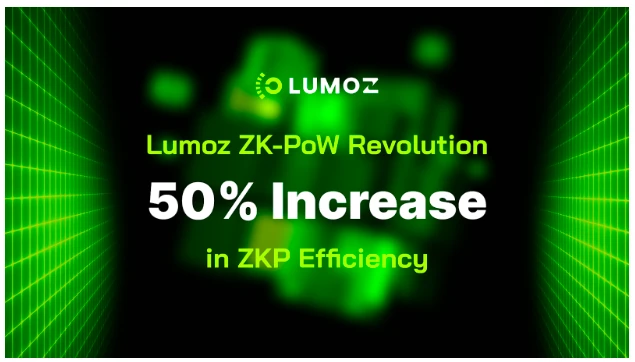Lumoz: معروف ZK-PoW الگورتھم، ZK کمپیوٹنگ کی کارکردگی میں 50% اضافہ ہوا
ماڈیولر کمپیوٹنگ لیئر RaaS پلیٹ فارم Lumoz نے حاصل کر لیا ہے۔ مرحلہ وار نتائج حوصلہ افزائی ٹیسٹ نیٹ کے ابھی ختم ہونے والے تیسرے دور میں۔ مارکیٹ کی سطح پر، ٹیسٹ نیٹ کی سرگرمیوں کو 1 ملین سے زیادہ صارفین اور 30 سے زیادہ معروف ماحولیاتی پروجیکٹ پارٹیوں کی توجہ اور حمایت حاصل ہوئی ہے، اور مارکیٹ کی مقبولیت، بحث، اور کمیونٹی پیمانہ نئی بلندیوں پر پہنچ گیا ہے۔ تکنیکی سطح پر، Lumoz ٹیم نے ZK-POW الگورتھم میں بھی گہری اصلاح کی ہے، اور موثر کامیابیاں بھی حاصل کی ہیں۔ فی الحال، یہ ZKP کی پروف کارکردگی کو مؤثر طریقے سے تقریباً 50% تک بہتر بنا سکتا ہے۔
معروف ZK AI ماڈیولر کمپیوٹنگ پرت کے طور پر، Lumoz PoW مائننگ میکانزم کو مؤثر طریقے سے رول اپ، ZK-ML اور ZKP تصدیق کے لیے کمپیوٹنگ پاور فراہم کرنے کے لیے استعمال کر سکتا ہے، اور اس کی بنیادی تکنیکی ٹیم اس کے لیے انتھک محنت کر رہی ہے۔ یہ تکنیکی اقدام نہ صرف مؤثر طریقے سے اسے آج کے سخت مسابقتی Web3 ZK کمپیوٹنگ فیلڈ میں نمایاں کرنے میں مدد کرتا ہے بلکہ آنے والے Lumoz ZK-POW مین نیٹ کے لیے بھی بنیاد رکھ سکتا ہے۔
Lumoz ZK-PoW الگورتھم کی اصلاح کا مخصوص مواد درج ذیل ہے:
موجودہ تصدیقی عمل میں بہتری
سب سے پہلے، Lumoz کی تجویز کردہ دو قدمی جمع کرانے والے الگورتھم اور آپٹمائزڈ ZKP جنریشن اسکیم نہ صرف ZK-PoW میکانزم کی وکندریقرت کو یقینی بناتی ہے، بلکہ ZK ثبوتوں کی جنریشن اور تصدیق کی کارکردگی کو بھی نمایاں طور پر بہتر کرتی ہے۔ الفا ٹیسٹ نیٹ کے دوران اس کی اچھی طرح تصدیق کی گئی ہے۔
اب، ایک طویل محنت کے بعد، Lumoz ٹیم نے تصدیق کے دوران آن چین وسائل کے استعمال کو کم کرنے اور تصدیق کے مجموعی عمل کو مختصر کرنے کے لیے ایک آسان تصدیقی عمل کا استعمال کرتے ہوئے اصل دو قدمی جمع کرانے کے ماڈل کو بہتر بنایا ہے۔ موجودہ عمل میں، مجموعی ثبوت کی تصدیق کی اسکیم اب بھی اصل جمع کرانے کی ونڈو اور ترغیباتی طریقہ کار کو برقرار رکھتی ہے، لیکن اصل دو قدمی توثیق کے عمل کی بجائے ایک آسان کنٹریکٹ کال کا استعمال کرتی ہے۔ آسان عمل میں، کارکنوں کو اب اپنی شناخت اور ٹاسک کی معلومات کو پروف ہیش کے ذریعے تصدیق کرنے کی ضرورت نہیں ہوگی، بلکہ وہ اپنی معلومات اور ٹاسک کی معلومات پر مشتمل پروف آئی ڈی کو تیار کردہ zk پروف میں جمع کریں گے، اور کنٹریکٹ میں تصدیق کو ایک وقت میں مکمل کریں گے۔ .
اس طرح، کمپیوٹنگ پاور فراہم کرنے والے کو اصل دو قدمی تصدیقی عمل کو مکمل کرنے کے لیے صرف ایک کنٹریکٹ کال کرنے کی ضرورت ہوتی ہے، آن چین اوور ہیڈ کو 50% سے 60% تک کم کر کے؛ ایک ہی وقت میں، ثبوت کا آن چین تصدیقی مرحلہ بھی اصل ونڈو پیریڈ کے بعد سے ونڈو پیریڈ کے آغاز تک بڑھا دیا گیا ہے، اور ٹرسٹ سٹیٹ تک پہنچنے میں لگنے والے وقت میں تقریباً 30% کی کمی ہو گئی ہے۔
تکرار اور ثبوت کی جمع
الگورتھم کی Plonky سیریز سے متاثر ہو کر، Lumoz نے ZK-PoW کی پروف جنریشن اسکیم کو بہتر بنایا اور مجموعی پروف جنریشن کی کارکردگی کو بہتر بنانے کے لیے ایک تکراری شکل متعارف کرانے کی کوشش کی۔ نئی اسکیم میں، متعدد ثبوت کے کاموں کے جنریشن کے مراحل کو متوازی طور پر انجام دیا جا سکتا ہے، اور آخر میں دھیرے دھیرے تکرار کے ذریعے ایک واحد ثبوت میں جمع کیا جا سکتا ہے، تاکہ پورے نظام کی ZK تصدیق کو مزید ہموار ثبوت اور کم تصدیق کے اوور ہیڈ کے ساتھ مکمل کیا جا سکے۔ دوسری طرف، تکراری شکل کے ذریعے، آپٹمائزڈ اسکیم کسی ایک کام کو ایک باریک گرانولریٹی میں بھی تقسیم کر سکتی ہے، جو کمپیوٹنگ پاور کے زیادہ معقول اور موثر مختص کی بنیاد فراہم کرتی ہے۔
زیادہ معقول کمپیوٹنگ پاور ڈسٹری بیوشن
ZK-PoW کے ترغیبی طریقہ کار کے تحت، Lumoz ZK کمپیوٹنگ نوڈس کی ایک بڑی تعداد کو مستحکم طور پر برقرار رکھنے کے قابل ہے۔ لہذا، زیادہ معقول کمپیوٹنگ پاور ایلوکیشن میکانزم کو ڈیزائن کرنے سے نیٹ ورک کی مجموعی پروف کمپیوٹنگ کارکردگی میں بہت بہتری آئے گی۔ Lumoz ٹیم نے اس سمت میں تحقیق اور بہتری بھی کی ہے:
حساب کے نتائج کا دوبارہ استعمال
پچھلے ورژنوں میں، ہر پروف ٹاسک کے حساب کتاب کا عمل نسبتاً آزاد تھا اور صرف نظام کے کچھ موجودہ حالت کے پیرامیٹرز پر منحصر تھا۔ اس عمل میں، حساب کے عمل کی ایک بڑی تعداد دہرائی گئی اور بے کار تھی۔ نیا حل کسی ایک پروف ٹاسک کو باریک باریک ڈویژن میں تقسیم کرنے کے لیے تکرار کا استعمال کرتا ہے، تاکہ نسبتاً آزاد پروف کاموں کے درمیان ملتے جلتے ماڈیول مل سکیں۔ ان ماڈیولز کے لیے، نیا حل حساب کے کچھ نتائج کو کیش کرے گا اور انہیں بعد کے عمل میں براہ راست دوبارہ استعمال کرے گا، ان بڑی مقداروں کو بار بار کیے جانے والے حسابات سے گریز کرے گا اور کمپیوٹنگ پاور کے استعمال کو بہت بہتر بنائے گا۔
دوسری طرف، ایک باریک گرانولریٹی پر، نوڈس حساب کے عمل کی درمیانی قدروں کو بہتر طریقے سے محفوظ کر سکتے ہیں، تاکہ غیر معمولی حالات میں بریک پوائنٹس سے حسابات کو تیزی سے دوبارہ شروع کیا جا سکے۔
قبل از حساب
وکندریقرت کی وجہ سے، ZK-PoW میں کمپیوٹنگ پاور ہمیشہ سپلائی جیسی نہیں ہوتی۔ ضرورت سے زیادہ کمپیوٹنگ پاور کو ضائع کرنے سے بچنے کے لیے، کمپیوٹنگ نوڈس کو حساب شروع کرنے سے پہلے ہمیشہ ثبوت کے کام کا انتظار کرنے کی ضرورت نہیں ہوتی ہے۔ آپٹمائزڈ سلوشن میں، یہاں تک کہ اگر نیا پروف ٹاسک فی الحال جاری نہیں کیا گیا ہے، نوڈ اس بات کا تعین کرے گا کہ آیا نیا ٹاسک نظام کی موجودہ حالت کی بنیاد پر پہلے سے حساب کے کچھ عمل کو بہتر انداز میں انجام دے سکتا ہے، اور بیکار استعمال کر سکتا ہے۔ حساب کے لئے وسائل. پروف ٹاسک کے جاری ہونے کے بعد، نوڈ اس بات کی تصدیق کرنے کے لیے کم سے کم اوور ہیڈ کا استعمال کرے گا کہ آیا پری کیلکولیشن کا نتیجہ درست ہے، اور پھر عام حساب کے عمل کے ساتھ آگے بڑھے گا۔ اس بے کار کمپیوٹنگ پاور کو استعمال کرنے سے، پروف جنریشن کی رفتار میں 25% اضافہ ہوا ہے۔
خلاصہ کریں۔
Lumoz ٹیم نے ZK-PoW حل کو تین پہلوؤں سے بہتر بنایا۔ اوپری سطح کی توثیق کے عمل میں بہتری نے آن چین تصدیق کے اوور ہیڈ اور قابل اعتماد حالت تک پہنچنے کے لیے درکار وقت کو کم کر دیا۔ بنیادی ثبوت اور کمپیوٹنگ پاور کے استعمال کے طریقہ کار کی اصلاح نے ثبوت بنانے کے لیے درکار وقت کو بہت کم کر دیا۔ نیا اصلاحی حل اصل وکندریقرت اور مارکیٹ پر مبنی ZK کمپیوٹنگ پاور پرائسنگ میکانزم کو برقرار رکھتا ہے، جبکہ کان کنوں کے اخراجات کو نمایاں طور پر کم کرتا ہے اور ZKP کی پیداواری کارکردگی کو مزید بہتر بناتا ہے۔
یہ مضمون انٹرنیٹ سے حاصل کیا گیا ہے: Lumoz: معروف ZK-PoW الگورتھم، ZK کمپیوٹنگ کی کارکردگی میں 50% اضافہ ہوا
متعلقہ: کرپٹو مارکیٹ ویدر وین: تین بیئرش وارننگز اور تین تیزی کے سگنلز کی ترجمانی
اصل مصنف: CRYPTO، DISTILLED اصل ترجمہ: TechFlow Cryptocurrencies، جیسے کہ زیادہ تر خطرے والے اثاثوں کو، اس وقت شدید میکرو ہیڈ وائنڈز کا سامنا ہے، جس کی وجہ سے مارکیٹ میں اتار چڑھاؤ اور خوف بڑھتا ہے۔ ان چیلنجوں کے باوجود، Bitcoin اور blockchain کی مضبوط قدر کی تجویز طویل مدتی تیزی کے نقطہ نظر کی حمایت جاری رکھے ہوئے ہے۔ مختصر سے درمیانی مدت میں کچھ چیلنجوں کی توقع کریں۔ حفاظت پر توجہ دیں، کھلا ذہن رکھیں، اور مواقع لینے میں محتاط رہیں۔ یہاں آپ کے حوالہ کے لیے تین بیئرش سگنلز اور تین تیزی کے سگنلز ہیں۔ بیئرش سگنل #1 – گولڈ بریک آؤٹ 2019 میں، جب سونا دوبارہ پھوٹ پڑا، بٹ کوائن اپنی بلندیوں کو چھو گیا۔ یہ پیٹرن مارچ 2024 میں اپنے آپ کو دہرائے گا۔ کیا 2025 سے پہلے 6-9 ماہ تک مارکیٹ ٹھنڈا رہے گی؟ ماخذ: Intocryptoverse (i) سونے میں بریک آؤٹ کیوں ہوتا ہے؟ ایک محفوظ پناہ گاہ کے طور پر، سونے کا رجحان ہوتا ہے…









